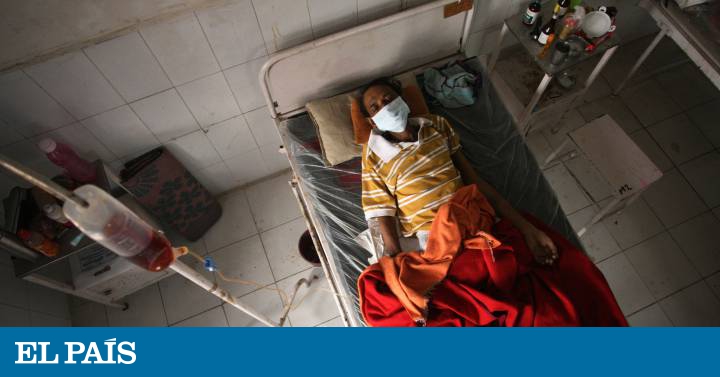Confinement measures imposed to combat the spread of covid-19 can increase deaths from tuberculosis by 1.4 million over the next five years and infections by up to 6.3 million more than expected before the pandemic. They are the conclusions of an investigation carried out by the StopTB Alliance in collaboration with Imperial College London, Avenir Health, USAID and Johns Hopkins University, which is leading the count of cases of the new coronavirus in the world.
MORE INFORMATION
- The mystery of the ancient vaccine that seems to prevent covid-19
- Everything that the coronavirus is going to stop: the fight against the epidemics that kill the most
- What you should know about coronavirus if you have HIV or tuberculosis
Although the scientific and medical community have already considered the brake that the new coronavirus will mean in the fight against some diseases such as malaria, HIV or tuberculosis, this analysis provides for the first time concrete figures on what can happen in the next five years with the advancement of the latter, which in 2018 alone killed 1.5 million people worldwide and infected ten million, according to the World Health Organization. Tuberculosis is a disease that almost always affects the lungs and is transmitted by the Koch bacillus, which is estimated to carry around a quarter of the world's population, almost always latently. However, individuals who develop their active form have bloody cough, fever, sweating, loss of appetite, and weakness that can lead to death if left untreated. Its eradication before 2030 is one of the purposes included in the Sustainable Development Goals approved by the UN.
To measure the potential impact of the new coronavirus in fighting the disease, the researchers asked two questions. The first, how much can restrictive measures in the short term affect the incidence and mortality from tuberculosis in the next five years in those countries with the highest viral load. The second is how and how long it will take to restore the mechanisms to fight the disease once the aforementioned measures to contain the coronavirus have been completed.
On the restrictions, it has been observed that they have helped to flatten the curve in the countries that have imposed them, but at the same time they are counterproductive in the battle against other evils. In the case of tuberculosis, confinement means overcrowding for the one billion people who live in slum neighborhoods around the world, with poor health and hygiene conditions. This is the perfect breeding ground for the transmission of the disease, which occurs when an infected person expels tubercle bacilli into the air by coughing or sneezing. It is enough for a person to inhale a few to become infected.
The other reason is that border closings and movement restrictions can "potentially" prevent the shipment of medical supplies, the researchers caution. In the case of tuberculosis, adherence to treatment is key to the patient's recovery. And, in fact, interrupting medication cycles can lead to the disease re-emerging in its most resistant version, which implies a longer, more expensive, painful cure with more side effects.
To obtain the results, the researchers have simulated several scenarios taking the data obtained in three countries where confinement measures have been imposed against covid-19: India, Kenya and Ukraine in better and worse scenarios, that is: what would happen with different periods of confinement first and recovery later. With the latter, the authors refer to the time it would take for a country to restore routine tuberculosis diagnosis and treatment services. The best scenario was two months of confinement and another two months of recovery of services. The worst: three months of confinement and 10 months of recovery of services.
Confinement makes diagnosis difficult, and this will lead to more undetected patients
The results obtained were extrapolated to create global estimates. Projections were made with the Indian model for countries with a high burden of tuberculosis in which the private sector is involved in its eradication; the Kenya model was taken as an example from countries where HIV is a driver of tuberculosis; and the Ukrainian model gave an idea of projections in countries with a high proportion of the disease in its drug-resistant version. However, the authors note that the results are very conservative because they have not taken into account the interactions between tuberculosis and covid-19, although the first analyzes in this field suggest that tuberculosis may aggravate the symptoms of coronavirus patients. .
The results indicate a decline of between five and eight years in the fight against the disease after years of progress, since figures of contagion and mortality similar to those of 2015 are obtained. The increase in deaths of 1.4 million and of infections in 6.3 million correspond to the worst scenario, the one in which the confinement lasts three months and the period of restoration of services lasts ten.
The researchers point out that any increase in tuberculosis patients that a country accumulates during this crisis period can make it difficult to control the infection for at least the next five years. "Rapid restoration of services is critical to minimize these adverse impacts," they advise.
The reason is that, during a period of confinement, difficulties in diagnosing and initiating treatment will lead to a growing group of undetected patients, and that will contribute to further expansion in the years to come. That is why complementary measures are also needed, "with a focus on reducing the prevalent group of tuberculosis," the report says. Such measures should combine intensive community participation, awareness raising work on the importance of maintaining diagnostic and treatment services, and active case finding, including rapid expansion of contact tracing to compensate for missed diagnoses during the closure period.
You can follow FUTURE PLANET on Twitter and Facebook and Instagram, and subscribe here to our newsletter.

